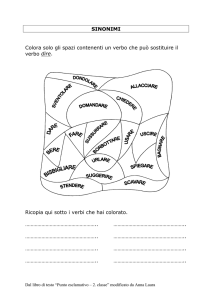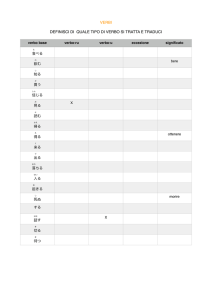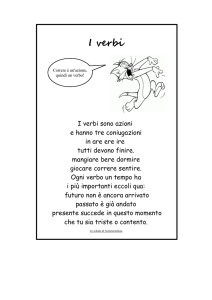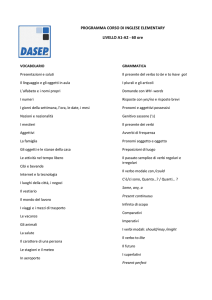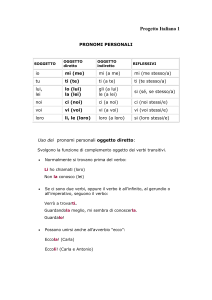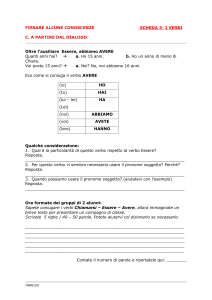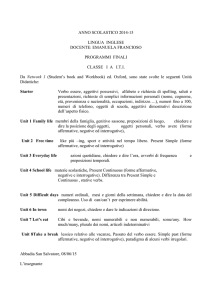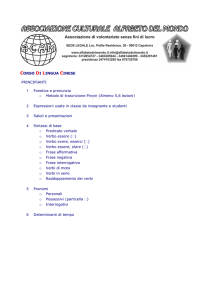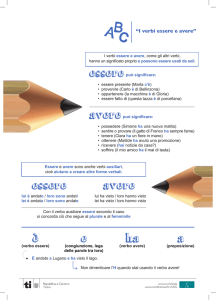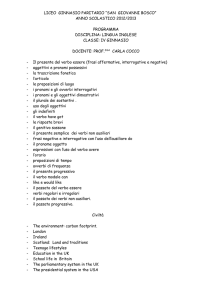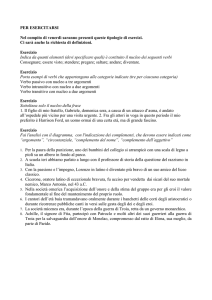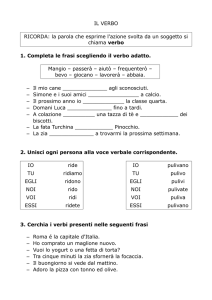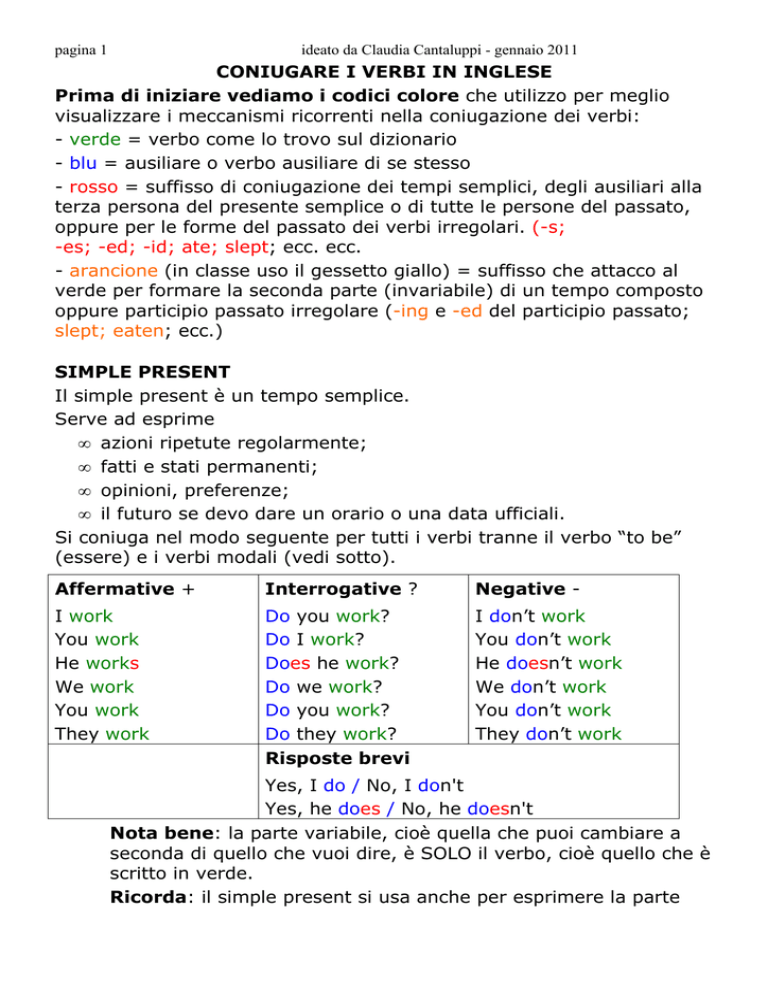
pagina 1
ideato da Claudia Cantaluppi - gennaio 2011
CONIUGARE I VERBI IN INGLESE
Prima di iniziare vediamo i codici colore che utilizzo per meglio
visualizzare i meccanismi ricorrenti nella coniugazione dei verbi:
- verde = verbo come lo trovo sul dizionario
- blu = ausiliare o verbo ausiliare di se stesso
- rosso = suffisso di coniugazione dei tempi semplici, degli ausiliari alla
terza persona del presente semplice o di tutte le persone del passato,
oppure per le forme del passato dei verbi irregolari. (-s;
-es; -ed; -id; ate; slept; ecc. ecc.
- arancione (in classe uso il gessetto giallo) = suffisso che attacco al
verde per formare la seconda parte (invariabile) di un tempo composto
oppure participio passato irregolare (-ing e -ed del participio passato;
slept; eaten; ecc.)
SIMPLE PRESENT
Il simple present è un tempo semplice.
Serve ad esprime
• azioni ripetute regolarmente;
• fatti e stati permanenti;
• opinioni, preferenze;
• il futuro se devo dare un orario o una data ufficiali.
Si coniuga nel modo seguente per tutti i verbi tranne il verbo “to be”
(essere) e i verbi modali (vedi sotto).
Affermative +
Interrogative ?
Negative -
I work
You work
He works
We work
You work
They work
Do you work?
Do I work?
Does he work?
Do we work?
Do you work?
Do they work?
Risposte brevi
I don’t work
You don’t work
He doesn’t work
We don’t work
You don’t work
They don’t work
Yes, I do / No, I don't
Yes, he does / No, he doesn't
Nota bene: la parte variabile, cioè quella che puoi cambiare a
seconda di quello che vuoi dire, è SOLO il verbo, cioè quello che è
scritto in verde.
Ricorda: il simple present si usa anche per esprimere la parte
pagina 2
ideato da Claudia Cantaluppi - gennaio 2011
subordinata di un periodo ipotetico di primo grado, cioè quella
che segue l'"if" e che in italiano si può esprimere sia col presente
che col futuro.
Il verbo essere e i verbi modali si coniugano come se fossero dei verbi
ausiliari, cioè “fanno da sé”, non vogliono nessuna parola che li aiuti a
fare domande e negative.
Confronta nelle due tabelle che seguono come si coniugano il verbo “to
be” e il verbo "can" (che si comporta come gli altri verbi modali: must,
should, could…).
Affermative +
I am
You are
He is
We are
You are
They are
Affermative +
I can
You can
He can
We can
You can
They can
Interrogative ?
Negative Are you ?
I am not
Am I ?
You aren’t
He isn’t
Is he ?
Are we ?
We aren’t
Are you ?
You aren’t
Are they ?
They aren’t
Risposte brevi
Yes, I am / No, I am not
Yes, he is / No, he isn't
Interrogative ?
Negative Can you ?
I cannot (can't)
Can I ?
You cannot (can't)
Can he ?
He cannot (can't)
Can we ?
We cannot (can't)
Can you ?
You cannot (can't)
Can they ?
They cannot (can't)
Risposte brevi
Yes, I can / No, I can't
PRESENT CONTINUOUS
Il present continuous è un tempo composto, cioè ha SEMPRE UN
AUSILIARE e il verbo che lo segue DEVE SEMPRE AD UNA CERTA
FORMA INVARIABILE.
Nel caso specifico, l’ausiliare è il verbo “to be” (essere), mentre il verbo
si modifica aggiungendo il suffisso -ing.
Il P.C. si usa quando descrivo
• azioni che si stanno svolgendo in questo istante o in questo
periodo (che percepisco come limitato);
pagina 3
ideato da Claudia Cantaluppi - gennaio 2011
• azioni già programmate con precisione nel futuro (in italiano si
utilizzerebbe il presente).
Non tutti i verbi si possono coniugare al present continuous! I verbi di
stato, di stato d’animo, di opinione, di possesso, NON si possono
mettere a questo tempo, così come non potresti usare lo “stare +
gerundio” in italiano (puoi dire “sto essendo triste” ????).
Affermative +
I am working
You are working
He is working
We are working
You are working
They are working
Interrogative ?
Negative Are you working?
I am not working
Am I working?
You aren’t working
He isn’t working
Is he working?
Are we working?
We aren’t working
Are you working?
You aren’t working
They aren’t working
Are they working?
Risposte brevi
Yes, I am / No, I am not
Yes, he is / No, he isn't
SIMPLE PAST
Il simple past è un altro tempo semplice che si usa per esprimere azioni
finite nel passato e determinate nel tempo. Nota la somiglianza nel
meccanismo di coniugazione col simple present!
Ricorda però che, nella forma affermativa, non puoi applicare la regola
di coniugazione a tutti i verbi (-ed), bensì solo a quelli regolari. Per
quelli irregolari devi conoscere la seconda colonna del paradigma. Però
puoi fare tranquillamente negative e interrogative senza conoscere la
forma irregolare!
Vedremo anche che il verbo "to be" anche nel caso del simple past fa
da sé, cioè si comporta come ausiliare di se stesso.
verbo regolare
Affermative +
Interrogative ?
Negative I worked
Did you work?
I didn’t work
You worked
Did I work?
You didn’t work
He worked
Did he work?
He didn’t work
We worked
Did we work?
We didn’t work
You worked
Did you work?
You didn’t work
They worked
Did they work?
They didn’t work
Risposte brevi
Yes, I did / No, I didn’t
pagina 4
ideato da Claudia Cantaluppi - gennaio 2011
verbo irregolare
Affermative +
I ate
You ate
He ate
We ate
You ate
They ate
Interrogative ?
Negative -
Did you eat?
Did I eat?
Did he eat?
Did we eat?
Did you eat?
Did they eat?
Risposte brevi
I didn’t eat
You didn’t eat
He didn’t eat
We didn’t eat
You didn’t eat
They didn’t eat
Yes, I did / No, I didn’t
verbo essere
Affermative +
I was
You were
He was
We were
You were
They were
Interrogative ?
Negative Were you ?
I was not
Was I ?
You weren’t
Were he ?
He wasn’t
Were we ?
We weren’t
Were you ?
You weren’t
Were they ?
They weren’t
Risposte brevi
Yes, I was / No, I wasn't
Yes, they were / No, they weren't
Ricorda: il simple past si usa anche per esprimere la parte
subordinata di un periodo ipotetico di secondo grado, cioè quella
che segue l'"if" e che in italiano si esprime col congiuntivo
imperfetto.
PAST CONTINUOUS
Il past continuous è un tempo composto, cioè, come gli altri già visti,
ha SEMPRE UN AUSILIARE e la parte del verbo DEVE ESSERE
MODIFICATA IN UN CERTO MODO.
Nel caso specifico, l’ausiliare è il verbo “to be” (essere) CONIUGATO
ALLA SUA FORMA PASSATA, mentre il verbo, come nel present
continuous, si modifica aggiungendo la forma in -ing.
Il Past Continuous si usa per descrivere
• azioni che si stavano svolgendo in un qualche momento del
passato e che sono state interrotte da una più breve: I was
sleeping when the telephone rang
(il mio dormire è stato interrotto dal suono del telefono);
pagina 5
ideato da Claudia Cantaluppi - gennaio 2011
• azioni che si stavano svolgendo in un momento preciso nel passato
ma erano iniziate prima e sono finite dopo quel momento:
- What were you doing at 8 o’clock last night?
- Ehm.... I was watching TV....
(domanda tipica in un interrogatorio...);
• azioni che si stavano svolgendo mentre una o più azioni brevi
avevano luogo:
While he was watching TV I cleared the table, washed up and
cleaned the kitchen...
(è tipico di una donna con marito pigro portare a termine almeno
tre cose mentre lui continua a guardare la TV...)
Non è difficile decidere se coniugare un verbo al Past Continuous o no,
perché anche in italiano abbiamo una costruzione equivalente col
verbo stare all’imperfetto + il gerundio:
Per esempio il primo esempio si può tradurre:
Stavo dormendo quando suonò il telefono
Come per il present continuous, non tutti i verbi si possono coniugare al
past continuous. I verbi di stato, di stato d’animo, di opinione, di
possesso, NON si possono mettere a questo tempo. .
Il Past Continuous si coniuga così:
Affermative +
Interrogative ?
Negative -
I was working
You were working
He was working
We were working
You were working
They were working
Were you working?
I wasn’t working
Was I working?
You weren’t working
Was he working?
He wasn’t working
Were we working?
We weren’t working
Were you working?
You weren’t working
Were they working?
They weren’t working
Risposte brevi
Yes, I was / No, I wasn't
Yes, they were / No, they weren't
PRESENT PERFECT
Il present perfect è un altro tempo composto, nello specifico dal verbo
“have” + il participio passato del verbo che vuoi coniugare.
Ricordati che il participio passato si forma aggiungendo -ed ai verbi
regolari. Se però devi coniugare un verbo irregolare devi utilizzare la
terza colonna del paradigma di ciascun verbo, che trovi alla fine di
qualunque libro di inglese e anche sul dizionario!
Il present perfect si usa
pagina 6
ideato da Claudia Cantaluppi - gennaio 2011
• quando esprimo un’azione che è stata svolta in un passato non
determinato, non definito (cioè se non specifico e non è
importante il quando) ma ha una ripercussione, un effetto sul
presente (lo posso tradurre con un "passato prossimo" italiano);
• quando utilizzo gli avverbi indefiniti just, already, yet, never, ever
per dire che oppure chiedere se una cosa è appena avvenuta, non
è mai avvenuta, è già avvenuta (lo posso tradurre con un "passato
prossimo" italiano);
• quando esprimo la durata uno stato che, iniziato nel passato,
prosegue nel presente; si usa tipicamente con "for", "since" e altre
espressioni che indichino durata (e.g. "all my life"). in questo caso
NON lo posso tradurre con un passato prossimo bensì con un
presente dell'indicativo:
e.g. I have been a teacher since 1990 =
SONO un'insegnante dal 1990
Il PP si coniuga così:
verbo regolare
Affermative +
Interrogative ?
Negative I have worked
You have worked
He has worked
We have worked
You have worked
They have worked
verbo irregolare
Affermative +
Have you worked?
Have I worked?
Has he worked?
Have we worked?
Have you worked?
Have they worked?
I have not worked
You haven’t worked
He hasn’t worked
We haven’t worked
You haven’t worked
They haven’t worked
Interrogative ?
Negative -
I have slept
You have slept
He has slept
We have slept
You have slept
They have slept
Have you slept?
I have not slept
Have I slept?
You haven’t slept
Has he slept?
He hasn’t slept
Have we slept?
We haven’t slept
Have you slept?
You haven’t slept
Have they slept?
They haven’t slept
Risposte brevi
Yes, I have/ No, I haven't
Yes, he has / No, he hasn't
FUTURO CON WILL
Il futuro con "will" è considerato un tempo semplice ma, a differenza di
quelli che abbiamo visto prima, si forma con l'utilizzo a tutte le persone
pagina 7
ideato da Claudia Cantaluppi - gennaio 2011
dell'ausiliare "will" seguito dal verbo, che non cambia mai.
Si usa principalmente quando devo esprimere:
• una previsione, una promessa, una supposizione;
• la seconda parte di una frase ipotetica di primo grado;
• una decisione presa sul momento.
Si coniuga nel seguente modo; nota la differenza con gli altri tempi
semplici: l'ausiliare NON compare solo nelle domande e nelle negative e
il verbo non cambia mai.
Affermative +
Interrogative ?
Negative -
I will work (I'll work)
You will work
He will work
We will work
You will work
They will work
Will you work?
Will I work?
Will he work?
Will we work?
Will you work?
Will they work?
Risposte brevi
I won’t work
You won’t work
He won’t work
We won’t work
You won’t work
They won’t work
Yes, I will / No, I won't
FUTURO CON "BE GOING TO"
Il futuro con "be going to" si forma utilizzando questa perifrasi (una
specie di "giro di parole") prima del verbo (che resta invariabile) e
serve per esprimere soprattutto:
• un'intenzione nel futuro;
• una previsione certa.
La perifrasi precede sempre il verbo ed è composta da una parte
invariabile (going to) e da una parte "ausiliare", variabile e che sposto o
modifico per domande e negative, il verbo essere.
Affermative +
Interrogative ?
Negative -
I am going to work
You are going to work
He is going to work
We are going to work
You are going to work
They are going to work
Are you going to work?
Am I going to work?
Is he going to work?
Are we going to work?
Are you going to work?
Are they going to work?
I'm not going to work
You aren't going to work
He isn't going to work
We aren't going to work
You aren't going to work
They aren't going to
work
Risposte brevi
Yes, I am / No, I am not
pagina 8
ideato da Claudia Cantaluppi - gennaio 2011
CONDIZIONALE PRESENTE
Il condizionale presente si forma come il futuro con "will" ma utilizzando
"would" come ausiliare.
Questa forma verbale serve non solo per esprimere il condizionale
presente (in tutti i casi in cui è necessario, come in italiano) ma anche il
futuro di un discorso indiretto nel passato ("futuro nel passato" - in
italiano utilizziamo il condizionale passato); si usa anche come tempo
narrativo per esprimere abitudini nel passato con i verbi d'azione (un
po' come il nostro "imperfetto").
Affermative +
Interrogative ?
Negative -
I would work (I'd
work)
You would work
He would work
We would work
You would work
They would work
Would
Would
Would
Would
Would
Would
I wouldn't work
You wouldn't work
He wouldn't work
We wouldn't work
You wouldn't work
They wouldn't work
you work?
I work?
he work?
we work?
you work?
they work?
Risposte brevi
Yes, I would / No, I wouldn't
PAST PERFECT
Il past perfect è un altro tempo composto che traduce gli italiani
"trapassato prossimo" e "trapassato remoto".
Serve per
• esprimere azioni o stati precedenti a quello di cui si sta
raccontando al passato;
• riportare nel discorso indiretto con verbo introduttivo al passato le
forme dirette del "simple past" e del "present perfect";
• la parte subordinata di un periodo ipotetico di terzo grado, cioè
quella che segue l'"if" e che in italiano si esprime col "congiuntivo
trapassato" (o "congiuntivo piuccheperfetto").
Come le forme PERFECT la parte ausiliare è il verbo "have", in questo
caso coniugato al passato ("had"), la parte invariabile è il solito
participio passato (-ed per i verbi regolari; terza colonna dei verbi
irregolari).
pagina 9
verbo regolare
Affermative +
ideato da Claudia Cantaluppi - gennaio 2011
Interrogative ?
Negative -
I had worked
You had worked
He had worked
We had worked
You had worked
They had worked
verbo irregolare
Affermative +
Had
Had
Had
Had
Had
Had
I had not worked
You hadn’t worked
He hadn’t worked
We hadn’t worked
You hadn’t worked
They hadn’t worked
I had slept
You had slept
He had slept
We had slept
You had slept
They had slept
Had you slept?
I had not slept
Had I slept?
You hadn’t slept
Had he slept?
He hadn’t slept
Had we slept?
We hadn’t slept
Had you slept?
You hadn’t slept
Had they slept?
They hadn’t slept
Risposte brevi
Yes, I had / No, I hadn't
you worked?
I worked?
he worked?
we worked?
you worked?
they worked?
Interrogative ?
Negative -
CONDIZIONALE PASSATO
Il condizionale passato è una di quelle forme verbali che in inglese
contengono non uno ma due ausiliari - qui would e have. Di queste solo
la prima varia a seconda delle persone (nel caso del condizionale è
comunque sempre uguale - would / 'd), si sposta nelle domande e
prende la negazione nelle negative. La terza parte della forma verbale
è, in questo caso, ancora participio passato (-ed per i verbi regolari;
terza colonna dei verbi irregolari).
Questa forma verbale si usa come il condizionale passato italiano, cioè
tipicamente nelle ipotetiche di terzo grado - ciò che "sarebbe successo
se…" (ma NON traduce il futuro nel passato, come si è già detto).
Nota bene: nella tabella che segue è illustrata solo la formazione
coi verbi regolari; quelli irregolari si comportano allo stesso modo
ma con il participio passato preso dalla terza colonna del
paradigma.
Attenzione: il condizionale passato dei verbi italiani "dovere" e
"potere", in inglese utilizzano "should" e "could" al posto di
"would". Nella seconda tabella vedrete l'esempio col secondo.
pagina 10
ideato da Claudia Cantaluppi - gennaio 2011
verbo regolare
Negative -
Affermative +
Interrogative ?
I would have played
You would have played
He would have played
We would have played
You would have played
They would have played
Would you have played?
Would I have played?
Would he have played?
Would we have played?
Would you have played?
Would they have
played?
I would not have played
You wouldn’t have
played
He wouldn’t have played
We wouldn’t have
played
You wouldn’t have
played
They wouldn’t have
played
Risposte brevi
Yes, I would / No, I wouldn't
Affermative +
Interrogative ?
Negative -
I could have come
You could have come
He could have come
We could have come
You could have come
They could have come
Could you have come?
Could I have come?
Could he have come?
Could we have come?
Could you have come?
Could they have
come?
I could not have come
You couldn’t have come
He couldn’t have come
We couldn’t have come
You couldn’t have come
They couldn’t have come
Risposte brevi
Yes, I could / No, I couldn't
Nota bene: al posto di could si usano may o might se si vogliono
fare delle supposizioni.
PRESENT PERFECT CONTINUOUS
Anche questa forma verbale è di quelle formate da tre parole e il suo
nome (PERFECT + CONTINUOUS) dovrebbe già suggerirvi che devono
esserci gli ausiliari "have" e "be" insieme ad un participio passato e una
forma in -ing…
E infatti il present perfect continuous non è altro che il present perfect
del verbo essere (have + been) seguito dalla forma in -ing dell'azione
che sto esprimendo. Di queste parole l'unica che in effetti si comporta
da ausiliare è la prima, cioè have.
Questa forma non ha una traduzione letterale in italiano, quindi bisogna
capire quando si usa e ricordarsi di farlo quando è necessario;
tipicamente si usa per
pagina 11
ideato da Claudia Cantaluppi - gennaio 2011
• esprimere la durata di azioni iniziate nel passato e che ancora
continuano nel presente (confronta col "present perfect"); in
questo caso ci deve essere un'espressione di durata, di solito con
l'uso di "for" o "since", oppure altre equivalenti (ad es. "all my
life").In italiano questo si esprime col presente dell'indicativo (o al
Massimo col presente di "stare + gerundio")
e.g. I have been teaching English for twenty years.
= INSEGNO inglese da vent'anni;
• esprimere azioni che sono appena terminate e di cui percepisco gli
effetti immediati
e.g. - You're all dirty!
- I have been working in the garden.
Come per il present c. e il past continuous, non tutti i verbi si possono
coniugare al present perfect continuous. I verbi di stato, di stato
d’animo, di opinione, di possesso, NON si possono mettere a questo
tempo.
Affermative +
Interrogative ?
Negative -
I have been playing
You have been playing
He has been playing
We have been playing
You have been playing
They have been playing
Have you been playing?
Have I been playing?
Has he been playing?
Have we been playing?
Have you been playing?
Have they been playing?
I have not been playing
You haven’t been playing
He hasn’t been playing
We haven’t been playing
You haven’t been playing
They haven’t been
playing
NOTE FINALI
Questo compendio NON ha la pretesa di essere esaustivo
• nel descrivere l'uso dei vari tempi verbali - ad esempio nel dare
tutte le sfumature nell'usare una forma piuttosto che un'altra per il
futuro (regole ed esempi molto più esaurienti nonché gli esercizi li
trovate su qualunque libro di grammatica);
• nel far vedere tutte le possibili forme abbreviate;
• nel dare le particolarità nell'uso del verbo have a seconda che
abbia significato di possesso oppure idiomatico ;
• nell'illustrare le regole di spelling per esempio nell'aggiunta della s o -ed o della forma in -ing …
L'intento qui era soprattutto quello di mostrare i meccanismi che sono
alla base della formazione di tutti i tempi verbali inglesi e che, con il
solo studio mnemonico delle forme irregolari al passato e participio
passato, vi consentono di costruire qualsiasi tempo, anche quelli che
non avete ancora affrontato.
pagina 12
ideato da Claudia Cantaluppi - gennaio 2011
Si noti per esempio
• che l'ausiliare (e nel caso ce ne siano due, solo il primo) si sposta
di norma davanti al soggetto nelle domande e prende la
negazione;
• che è solo l'ausiliare che si usa nelle risposte in breve;
• che l'ausiliare delle risposte in breve affermative NON può essere
abbreviato;
• che tutti i tempi continuous hanno il verbo essere e la forma in
-ing;
• che tutti i tempi perfect hanno il verbo avere e il participio
passato…
Ora sono sicura che ora saresti in grado di dire come si formano i
seguenti tempi composti:
• past perfect continuous
• future continuous
• future perfect continuous
• condizionale perfect continuous
pur senza sapere quando si utilizzano.

